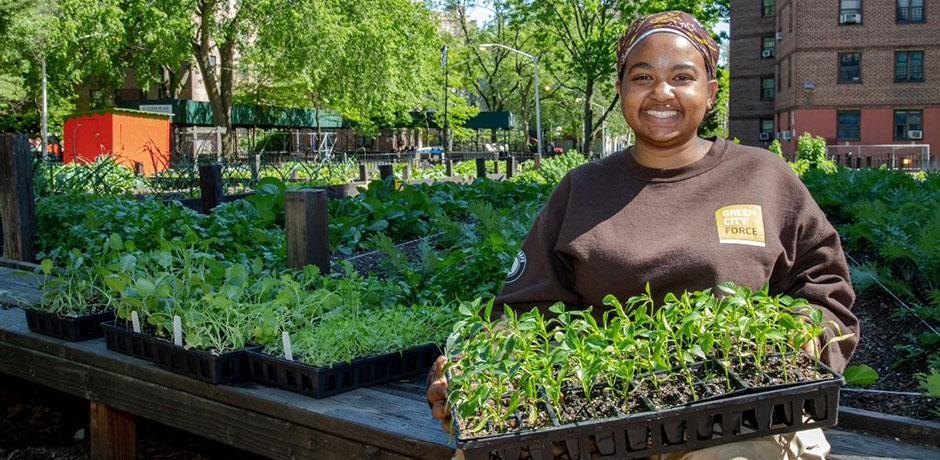The Main Principles Of City Blooming
The Main Principles Of City Blooming
Blog Article
Things about City Blooming
Table of ContentsExcitement About City BloomingThe Buzz on City BloomingNot known Details About City Blooming The 20-Second Trick For City BloomingCity Blooming - An Overview
Interested in growing food for sale in the City of Chicago? Below is a listing of frequently asked concerns pertaining to the regulations and laws that farmers must consider when planning a city agriculture task.
The zoning change does not customize any type of various other codes dealing with composting, structure licenses, acquiring or leasing City possessed property, organization licenses or environmental contamination. There are existing codes that control these issues and they continue to be in full result and may be applicable to your project. Area gardens are typically owned or handled by public entities, public companies or community-based organizations and kept by volunteers.
Urban ranches grow food that is meant to be marketed, either on a nonprofit or for-profit basis. As a result of their commercial purpose, city farms call for an organization permit. Yes. An area yard is permitted to market surplus generate that was grown on site if the sales are accessory or secondary to the garden's primary objective explained over.
The smart Trick of City Blooming That Nobody is Discussing
Composting is permitted however only for plant material that is created and used on website. The quantity of garden compost product can not go beyond 25 cubic backyards at any type of given time according to the requirements in 7-28-715 of the City's Municipal Code. Yes. Since the soil at most new yard websites needs modifying, garden compost, soil, timber chips, or other products can be obtained to build or boost the expanding area - home and garden.

If a structure authorization is called for then the hoophouse will be taken into consideration an accessory building. You can discover more regarding the structure permit demands by speaking to the Division of Buildings. The 25,000-square-foot dimension limitation is meant to stop a solitary area yard from controling an offered block or diminishing the block's existing residential or business personality.
The limitation does not use to yards located in Public Open Room (POS) districts. Can there be greater than one neighborhood garden that is 25,000 square feet on a solitary block? Yes. The size limitation relates to private yards, not to specific blocks. No. Fencing is not required, nonetheless, gardens that have big parking lot might be called for to mount fencing or other landscaping attributes.
Top Guidelines Of City Blooming
B1 & B2 districts require that all business usage tasks be conducted indoors. R districts limit industrial activity. The policies mirror the purpose and intent of the Zoning Code. Is secure fencing needed for metropolitan farms? Yes. Fences might be needed, in addition to landscape design and screening, for certain auto parking locations and outside job or storage locations relying on area and the details task happening.
Urban ranches need building authorizations and zoning approvals prior to construction (indoor plants). Various other types of city evaluation may be needed depending on particular structures, tasks, size, landscaping, licensing, public health and stormwater management problems.
Yes. The sort of license is identified by what is happening at the website. The Department of Organization Affairs and Customer Protection can aid establish the certain kind of service certificate that's required. Yes. Off road vehicle parking is needed for many business projects in Chicago. The required variety of auto parking rooms is based on the variety of staff members functioning on site and not the square video of the growing room.
Fascination About City Blooming

Yes. A metropolitan farm can market compost material created on website, however, the operation needs to follow the laws in 7-28-715 of the Chicago Municipal Code. Yes. Aquaponic systems are permitted indoors on city farms in many zoning districts. However, a zoning evaluation and structure authorization is called for in order to set up structures or systems and a service certificate is needed as defined above.
Up to five hives or colonies of honey bees may be maintained as an accessory usage. Beekeepers should register with the Illinois Department of Farming. To find out more concerning the recommended zoning amendment you may get in touch with the Division of Real Estate and Economic Growth, Bureau of Preparation and Zoning at 312.744.8563.
Farming in cities and metropolitan locations A city farm in Chicago. Urban agriculture describes numerous practices of growing. https://soundcloud.com/cityblooming, handling, and dispersing food in city locations. The term also puts on the location activities of pet husbandry, aquaculture, beekeeping, and cultivation in an urban context. Urban farming is identified from peri-urban agriculture, which happens in backwoods beside suburbs.
Some Known Facts About City Blooming.
It can include an activity of organic cultivators, "foodies" and "locavores", who seek to create socials media started on a shared principles of nature and community holism. These networks can create using formal institutional assistance, ending up being incorporated into neighborhood community planning as a "transition town" activity for sustainable city growth.
Some of the very first proof of city agriculture comes from Mesopotamia.
Report this page